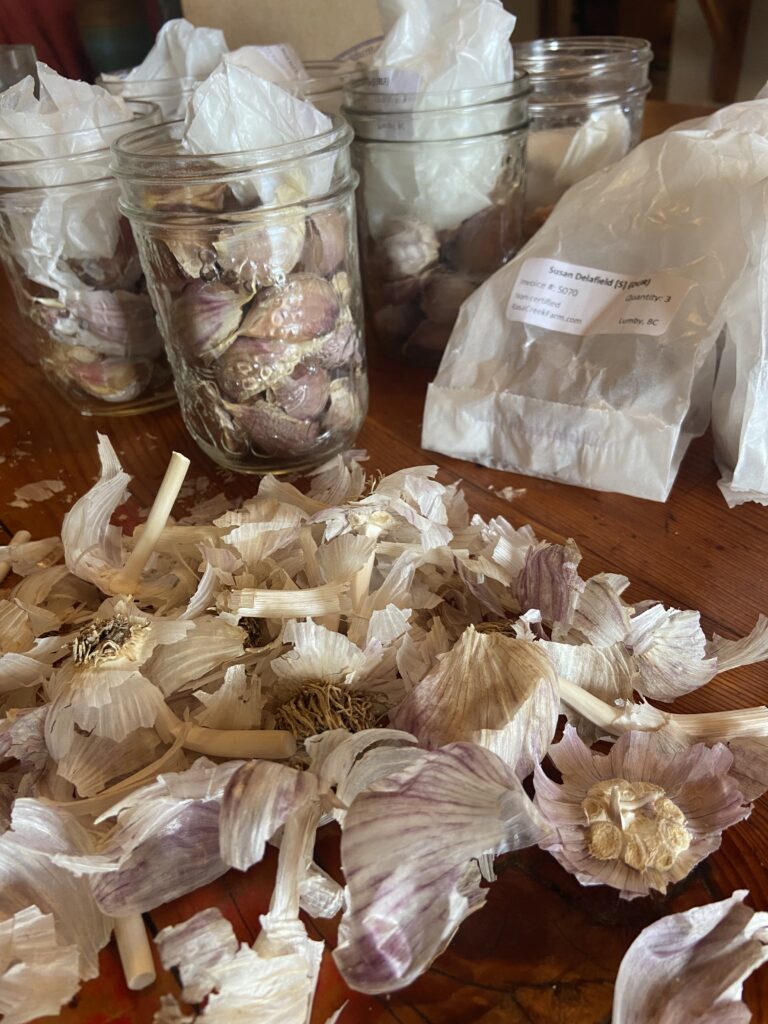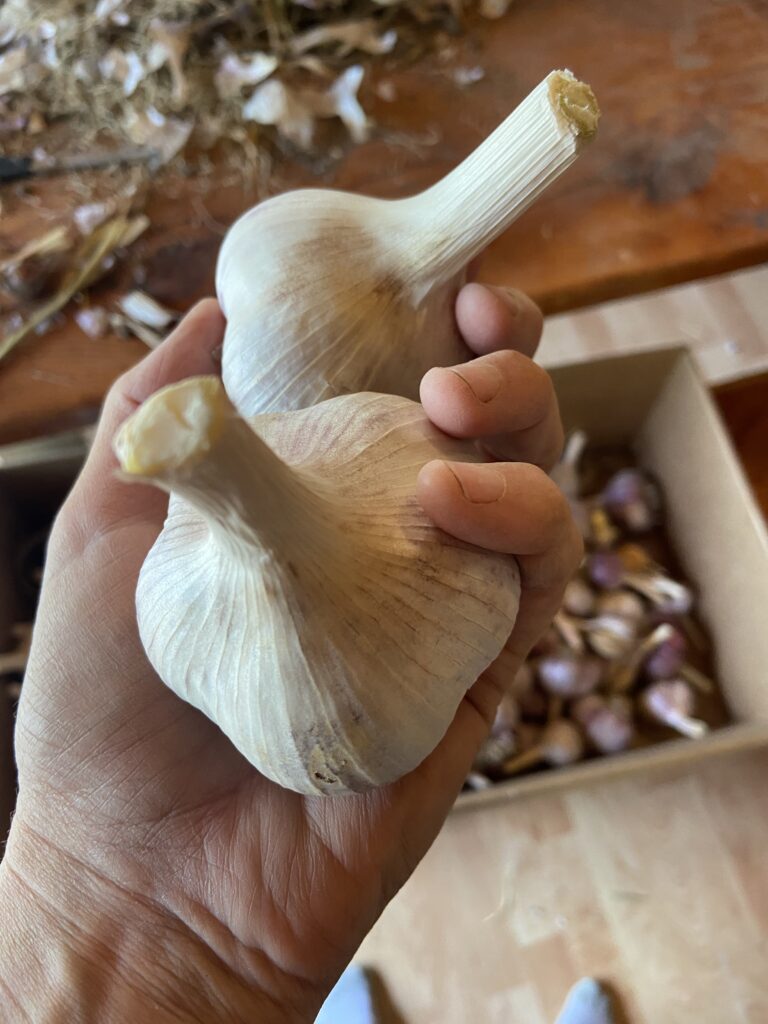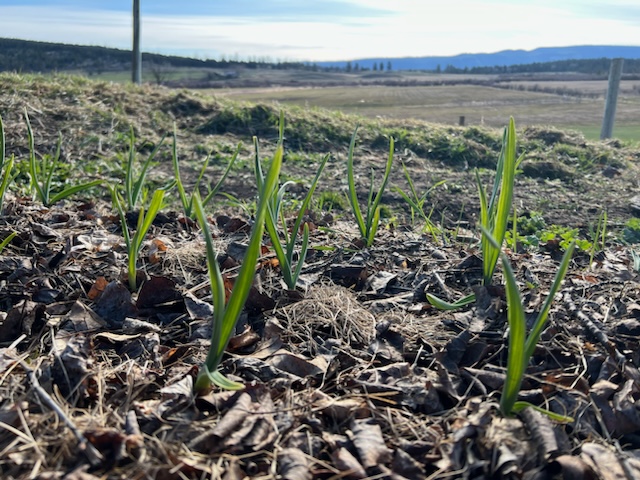I don’t know about you, but garlic is one of the vegetables that we use ALL of the time! Garlic has become a staple in my garden and I hope this article will make it a staple in yours as well. I am going to be sharing with you the best garlic growing tips from soil preparation to harvesting the garlic.
If you aren’t yet growing your garlic, I hope to convince you to try it this year. Garlic is one of the easiest vegetables to grow in home gardens and is easy to preserve, as it stores well. Garlic can be planted in the autumn, shortly before the ground freezes or in the spring as soon as the ground is workable. For us, we plant it in late October. I grow mine in rich compost and mulch it well with leaves and grass clippings. In the spring, garlic is one of the first signs of green that pops up in my garden.
Types of Garlic
There are two main types of garlic, soft neck and hard neck.
- Softneck garlic grows best in milder climates and has a mild flavour and papery skin. Typically softneck varieties store better than their hardneck counterparts, but I have found hardneck varieties to keep very well if appropriately cured. Softneck varieties tend to grow their garlic bulbs in layers with smaller garlic cloves that form a more small garlic bulb..
- Hardneck varieties are more hardy and can grow in areas that experience harder winters and produce large bulbs. Hardneck garlic has a central stem that is referred to as a scape. The scape of a hardneck garlic can be harvested and eaten. Hard neck garlic tends to have a more bold and complex flavor. This garlic is generally grown with 6-8 large individual cloves arranged in a single layer around the central stem.
Varieties of Hardneck Garlic
- Elephant Garlic
- Russian Red Garlic – my personal favorite garlic to grow.
- Music Garlic
- Purple Striped
- German White
All hardneck garlic plants tend to have a uniform bulb size with single layer, larger cloves.
Softneck Garlic Varieties
- Inchelium Red – a garlic that is striped with purple and white and has a milk taste.
- Lorz Italian – a garlic that is very heat tolerant, with a bold flavor.
- Silverwhite – one of your common grocery store varieties. It has a mild flavor and is great for braiding and long term storage.
These are some of the more common varieties of both softneck and hardneck garlic. There are many others out there. If you try to grow any garlic, I would love to hear what your favorite variety is.

What Kind of Soil Does Garlic Need?
When it comes time to plant your garlic, soil type will greatly influence where you plant. Find an area of well-drained soil that is full of organic matter. This kind of soil is commonly referred to as a sandy loam. You will want to make sure the soil is not too wet and is in a spot that receives full sun. If the soil is too wet, you will risk your garlic cloves rotting.
Next step is to make sure your garlic plot has the appropriate nutrients and pH level. Garlic requires soil that is very nutrient dense with nitrogen, phosphorus, and potassium. The best way to assure your soil has the appropriate nutrients and soil pH is by taking a soil sample of the soil. To do this you will take a sample from various spots in your garden and send them to a testing center as directed on your soil test instructions. It is best if you can lay a 3 inch layer of organic compost, such as rabbit waste and aged manure, over top of your soil surface and mix it in. After this, you can plant the garlic at its corresponding time of year.
When and How to Plant Garlic
When you plant your garlic will be influenced by whether or not it is hardneck or softneck garlic. The average growing season for garlic is 180-210 days. Softneck garlic is commonly planted in the early spring, as soon as the ground is workable. It will yield a fall harvest. Whereas hardneck garlic is planted in the fall and will yield a late June. When planting your garlic cloves, you will want to be sure that the clove still has its protective papery wrapping on it. A bare clove is more likely to rot.
Sowing Hardneck Garlic is done two weeks before your first frost date.
- Weed your garden
- Add and mix organic compost
- Plant your individual cloves of garlic around 3″ deep and 6″ apart with the pointed side up.
- Cover cloves with dirt and then layer a 6″ layer of mulch on top of it. Leaves or straw mulch are commonly used for garlic.
- Now is where you need to be patient. You will not see much change in your garlic until spring.
Sowing softneck garlic is very similar. The only difference is that it does not have to be mulched after planting and that it is done during spring planting. As long as the cloves are covered with dirt, it will grow. You only mulch the hardneck, fall planted garlic to help protect it from the cold winters and as a weed control.

When to Harvest Garlic
During the growing period, garlic will grow lovely green leaves, similar to that of onion, only flat and very fibrous. During the following summer, around 6-8 weeks before harvesting, hardneck garlic will send out shoots, called scapes, which, if left on the plant, will form a flower and little garlic seeds. These flower stems can be harvested when they start to curl around, which when harvested can extend the growing time of the bulb, and they have the bonus of being delicious! The consequence of not removing the scape is the result of small bulbs of garlic, as the scape will take nutrients and water from the forming garlic bulb, slowing its maturity down. I snap my scapes off right where they grow out of the leaves and use them just as I would garlic in recipes. I’ve fermented them, pickled them, made pesto and dehydrated them to make garlic salt. Remember softneck types of garlic generally do not produce a garlic scape.
You will harvest your bed of garlic when the bottom 5 leaves of the plant turn brown and die off. This will help assure you that the garlic bulb is fully matured. For hardneck garlic, this will be around early to mid-summer, depending on your location. For softneck garlic, this will be in the late fall.
Like onions, garlic must be cured in a well-ventilated place from direct sunlight. I use my covered porch. You’ll know your garlic is cured when the leaves are completely dry and the skins on your garlic are papery and dry.
How to Store Garlic
Garlic is best if stored in a dark, cool environment with good airflow. The temperature should be between 60 and 65 degrees in the area where you store bulbs of garlic. When storing garlic, you can braid the garlic stem together so that they hang easier. You can also store them in mesh bags. Be sure that no matter how you store them, the garlic has a good amount of air circulation.
If you choose to not plant some of your homegrown garlic the following year, you will want to make sure to order your planting bulbs in early summer as they sell out quickly. They will ship to you around August or September, depending on where you live and when you need to plant them.

Conclusion
I hope this garlic growing guide helped make you feel confident enough to grow your own garlic. If you have any questions about the garlic growing process, the soil testing process, or the harvesting process, comment below and we will get you the answer.
Happy Growing!




7 thoughts on “The Best Garlic Growing Tips”
Thank you for this information. I would like to try plant garlic. I really needed the tips on storing it too. Really enjoy your videos, messages and instagrams etc. I watched your video on canning tomatoes and canned along with you for my first time. All worked out great! Looking forward to many more projects .
I usually leave one scape on one plant and when it pointing up straight harvest my crop. Chelsea how do you determine when it’s time to pull your garlic?
Hi Valerie,
The garlic is ready to harvest when the bottom 4 or 5 leaves of the plant turn brown and begin to die off.
Happy Mother’s Day to you and all mothers where we be without them !
Finally got a good crop of garlic growing this year and we are selling our house! Can I transplant them if I dig a lot of earth from around each bulb? I don’t want to leave them behind.
Hi Cheryl,
You can replant it as long as you leave the roots in tact as best as possible and a good amount of soil around the bulb. Depending on where you live and your moving date, you might be able to harvest it the day you move. Garlic is usually harvested in June or July depending on your growing zone. Look for the bottom 4 or 5 leaves to become brown and die off. Once they do, it will be time to harvest.